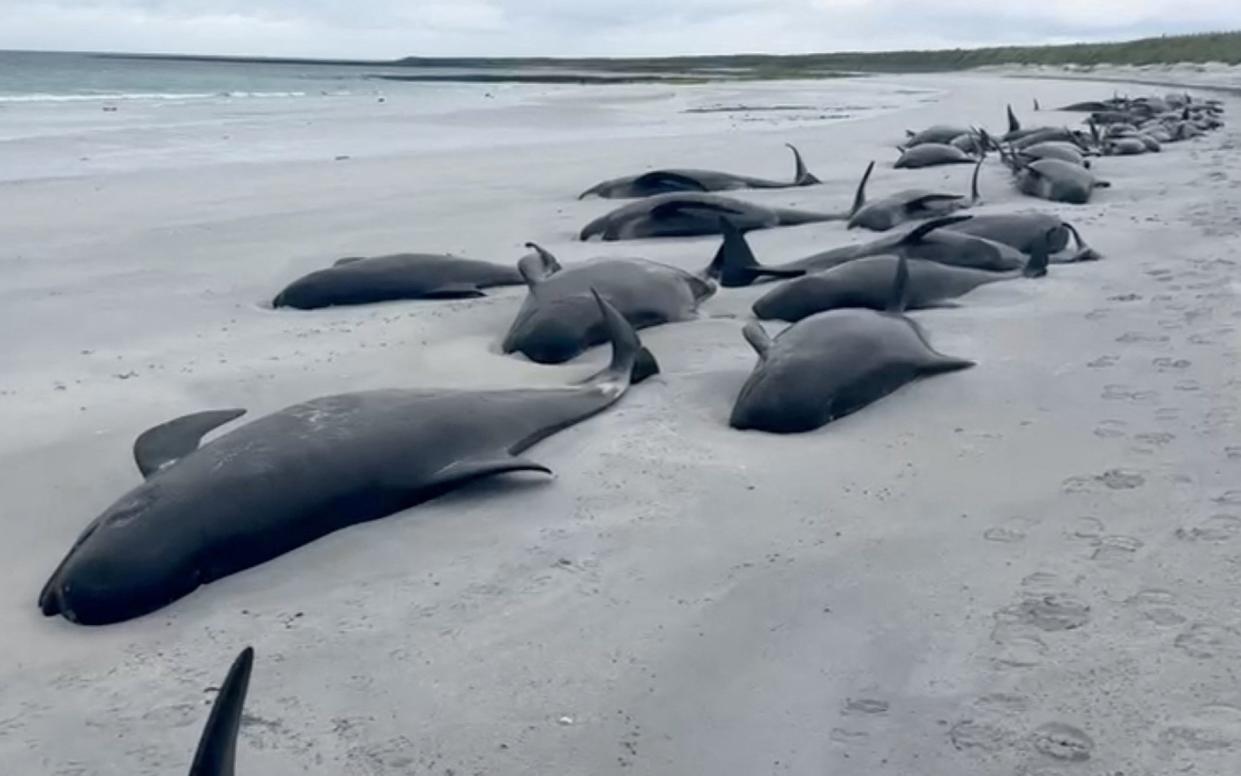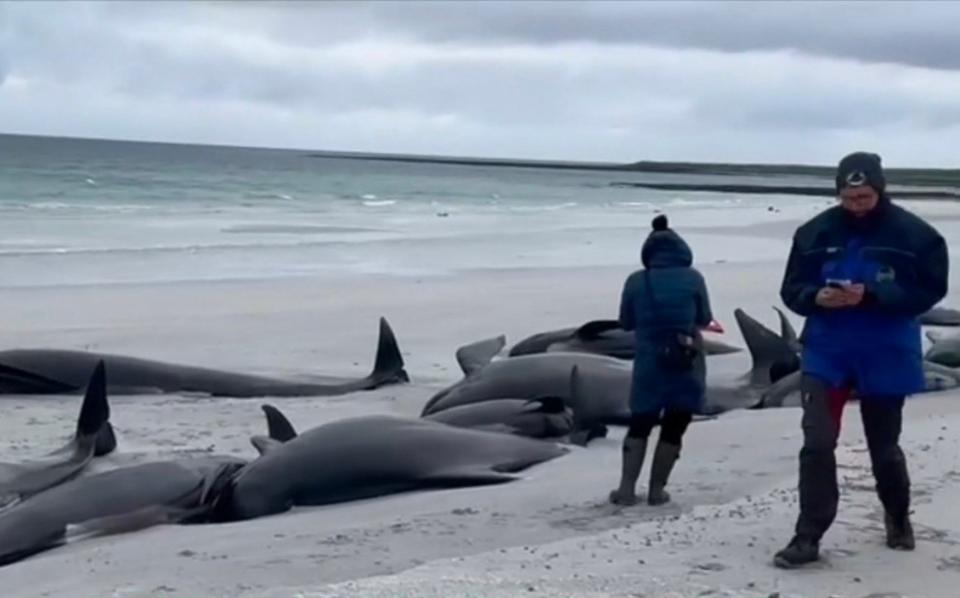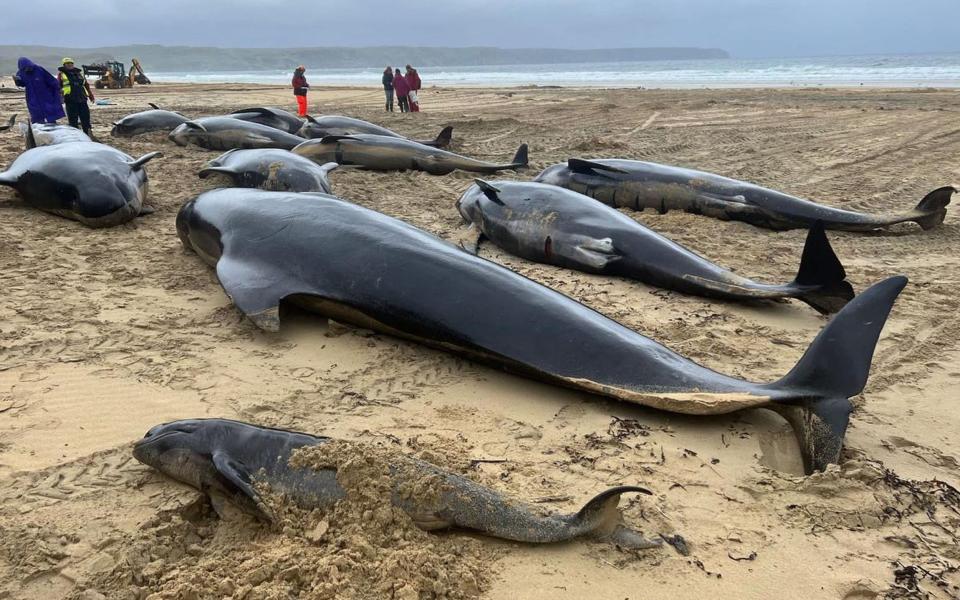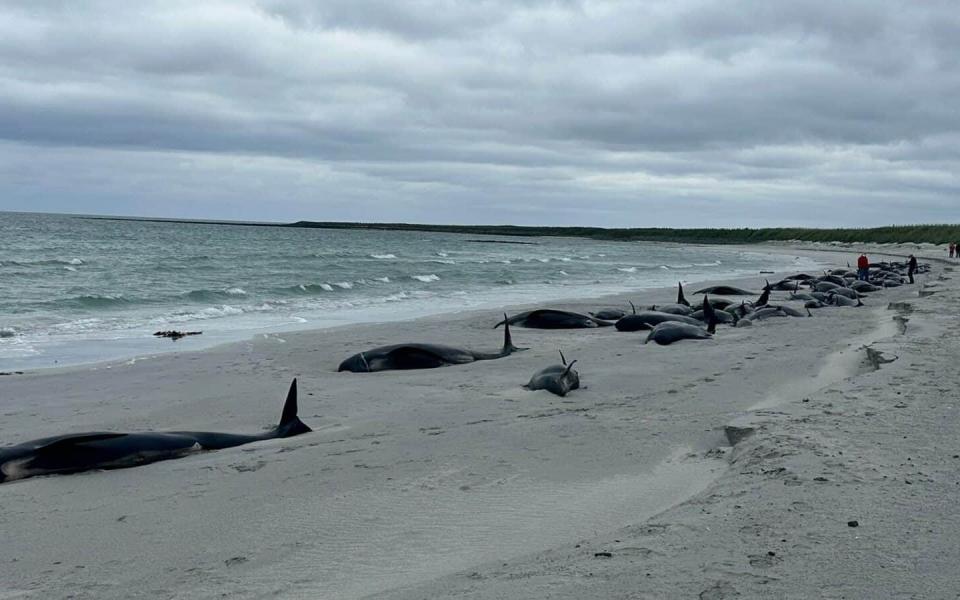‘We’ve got to do right by these animals’: Unpicking the mystery of the 77 beached whales

It is a scene of appalling devastation: a stretch of pristine white sand, littered with the lifeless bodies of dozens of whales. In total, 77 carcasses are strewn across the beach – an entire family group. Among them youngsters, barely a year old, adult females, and a fully-grown male seven metres long. Even in death, they are magnificent creatures.
The ghastly line of bodies is the result of the biggest mass stranding in Britain for a century – described even by seasoned whale conservationists as “heartbreaking”.
Few could be unmoved by the magnitude of the tragedy, which is compounded by a further cruel twist. When the animals, a pod of pilot whales, were discovered by a walker on Wednesday [July 10] – on Tresness Beach on Sanday island in Orkney – 12 were still alive, thrashing their tails in distress and struggling to breathe. Alerted to the discovery, experts and conservationists raced to the remote spot but attempts at rescue were in vain.
With the whales stranded beyond the reach of the tide there was no possibility of putting them back out to sea. And with the survivors slumped on their sides, they struggled to breathe. Efforts to move them upright were hampered by the soft sand: no matter how hard the rescuers tried to right the massive creatures, they simply collapsed back again.
A hard decision had to be made: a marksman was summoned to euthanise them.

Nick Davison, strandings coordinator for Scottish Marine Animal Stranding Scheme (SMASS), described his shock at seeing the stranding – and the harsh reality of putting down the survivors.
“I’ve seen a few mass strandings but this is by far the biggest,” he says. “It all struck home when I walked over the sand dunes to see 77 whales – in a range from big adult males to little calves maybe a year or so old – strewn right across the beach and all dead. It’s heartbreaking, particularly when this is probably an entire family group that’s been wiped out completely.
“The guys did a sterling effort and tried to refloat the ones that were found still alive, but they didn’t have the kit,” he explains. “It’s a shallow beach and these animals, particularly the big males, can weigh up to two tons. The tide didn’t come in far enough to refloat them. So unfortunately the decision had to be made for welfare reasons. It was tough; everybody has a soft spot for cetaceans and it’s hard to go up to a young pilot whale and pull the trigger. But it was the only thing to do – to put them out of their misery.”
However, after the grim discovery midweek and frantic rescue mission, by Friday afternoon the focus had shifted to a different but equally determined effort: to solve the mystery of why the whales came to be stranded. Initial inspections suggest they were well-fed and in good physical shape. So did a viral infection cause them to become confused? Were they spooked by killer whales? Did their group loyalty cause them to follow a sick leader onto the sand?
Or, as some people fear, is this actually a man-made disaster? Were the whales – who rely on their sensitive hearing and echo-location for communicating, navigating, hunting and feeding – deafened or disorientated by the sonar, the drilling, or the explosions in our increasingly noisy oceans?
To answer these questions, a team of experts – biologists, conservationists, pathologists and vets – have been scrambled from across the UK to this remote corner of Scotland. Working against the clock, they are rushing to measure and inspect the carcasses, and to collect and preserve samples of brain tissue, blood, skin and blubber. The task must be completed before the tissues are degraded by the natural process of decomposition. But a greater sense of urgency also drives their work.
Almost exactly a year ago, an entire pod of 55 pilot whales died on the Isle of Lewis in the Outer Hebrides. And soon-to-be-published research data given to The Telegraph suggests that mass strandings are becoming more common – and also happening on an ever larger scale.

So the race is not just to find out what happened to the whales in Orkney – but also to establish what is driving the trend and to determine whether anything can be done to prevent yet more deaths.
Coordinating the investigations is Dr Andrew Brownlow, director of SMASS. “If you’ve ever been onto a beach and seen a mass stranding like this, it is horrific, visceral, brutal,” he says. “We want to do whatever we can to try and understand this – and try to stop it from happening again.”
But following preliminary inspection, Davison can provide no answers as to why the whales beached: “We managed detailed examinations of four adult females who all looked in pretty good condition with nice, rounded bodies. We found remains of squid in the younger of the animals – so they had certainly been successfully foraging until very recently.”
Pilot whales are highly social animals that can live in small groups, but also in giant pods of over 1,000. Black or dark grey, they have a prominent, curved, dorsal fin. They can be found across the north Atlantic, the North Sea and the western Mediterranean and they hunt squid as well as mackerel and cod.
Throughout history whales have died in mass strandings – with the largest recorded in the UK in 1927 when 126 whales died in the Dornoch Firth in the Scottish Highlands. But data – due to be published by Dr Brownlow’s research team – suggests the problem is getting worse.
Since 1992, he explains, a total of 13 pilot whale strandings in Scottish waters have involved three or more individual animals. But the vast majority – 10 – have all occurred since 2010. “We have been monitoring very closely for the last 32 years,” says Dr Brownlow, “and we have seen two patterns that are potentially concerning in terms of mass strandings – increases in both frequency and magnitude.”
The challenge now, he explains, is to harness all available information – from post-mortems, lab tests and even records of underwater activity – to unpick the roots of the tragedy. “The main part is to understand the health of the animals both individually and as a pod based on what we can learn from post-mortem inspection: from the body condition to the presence of infectious diseases, viruses, bacteria, parasites and any physiological problems.”

The whales’ hearing may well be key to understanding what went wrong. “This is a species that uses sound to communicate, to find food, to navigate, for all of the basic life processes,” explains Dr Brownlow, “so if there’s something up with the hearing or their ability to echo-locate then that could be majorly important. If there’s been an excessive noise or protracted amounts of noise then cells in the auditory apparatus can become damaged: they don’t repair – and you can detect that damage at post-mortem.
“But the problem is, there are a huge range of behavioural responses to noise or disturbance, both human and natural – be it earthquakes or killer whales or the usual suspects like sonar, military activity, pile-driving, or detonation of explosives – and not all the ways a socially complex animal responds to those can be detected at post-mortem. You can’t detect if it’s scared, if it’s lost, if it’s made a bad decision.”
Dr Brownlow’s team is now pulling in information from as wide a number of sources as possible – “from the military, from buoys, from records of underwater logs” – to get a handle on whether there has been a notable increase in noise. But while those investigations are under way, the stranding also presents a huge logistical problem: how to dispose of around 50 tons of whale carcasses?
“These animals are a really important part of the marine ecosystem and actually the best thing that we can do, where possible, is to bury them close to the sea,” explains Dr Brownlow. “I think the only option is to use a digger so they can be buried in the fields beside the coast, where they’ll be piled up and covered in sand. They’ll very quickly decompose so the nutrients go back into the marine environment.”
Once the practicalities have been attended to, the task ahead for Dr Brownlow and his team will be one of critical importance, if the UK is to avoid more mass beachings in the coming years.
“The biggest mass stranding event we had seen in Scotland was last year in Lewis and that was 55 animals,” he says. “Now, a year later, we’re here again with another case; this time 77 animals have died because of being stranded or being euthanised for welfare reasons.
“The human relationship with cetaceans is very curious and very powerful,” he adds. “They are social, highly complex beings that have an advanced social structure and communication. They are clearly intelligent. I think people feel a connection with them in the way they do with other highly intelligent animals, such as elephants and primates.
“We’ve got to do right by these animals. We’ve got to do something to try to stop this.”

